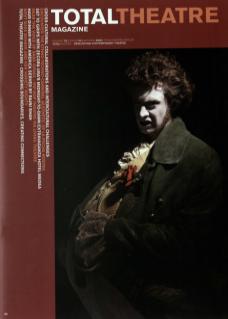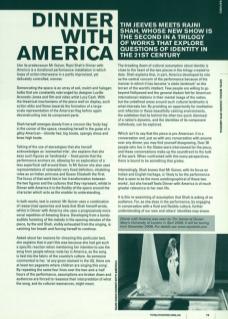Like its predecessor Mr Quiver, Rajni Shah's Dinner with America is a durational performance-installation in which loops of action interweave in a partly improvised, yet delicately controlled, manner.
Demarcating the space is an array of soil, mulch and halogen bulbs that are constantly rearranged by designer Lucille Acevedo-Jones and film and video artist Lucy Cash. With the theatrical mechanisms of the piece well on display, such action ebbs and flows towards the formation of a large-scale representation of the American flag before again deconstructing into its component parts.
Shah herself emerges slowly from a cocoon-like 'body bag' in the corner of the space, revealing herself in the guise of a glitzy American – blonde hair, big boobs, spangly dress and knee-high boots.
Talking of the use of stereotypes that she herself acknowledges as 'somewhat trite', she explains that she sees such figures as 'landmarks' – fixed points that the performance anchors on, allowing for an exploration of a less superficial self around them. In Mr Quiver she also uses representations of ostensibly very fixed definition, inhabiting roles as an Indian princess and Queen Elizabeth the First. The focus of that work lies in her transformation between the two figures and the cultures that they represent, whilst in Dinner with America it is the fluidity of the space around the character which acts as the enabler to understanding.
In both works, text is central. Mr Quiver uses a combination of researched speeches and texts that Shah herself wrote, whilst in Dinner with America she uses a progressively more vocal repetition of Amazing Grace. Developing from a barely audible humming of the melody in the opening minutes of the piece, by the end Shah, visibly exhausted from the singing, is catching her breath and forcing herself to continue.
Asked about her reasons for choosing this particular text, she explains that in part this was because she had got such a specific reaction when mentioning her intention to use the song from people whose roots lay in America, as the song is tied into the fabric of the country's culture. As someone commented to her, 'at any given moment in the US, there are at least ten pageants where children are singing this song'. By repeating the same four lines over the two-and-a-half hours of the performance, assumptions are broken down and audiences are forced to reassess their interpretation of what the song, and its cultural resonances, might mean.
The breaking down of cultural assumption about identity is close to the heart of the two pieces in the trilogy created to date. Shah explains that, in part, America developed its role as the central concern of the performance because of the manner in which it has become 'a static landmark on the terrain of the world's intellect’. Few people are willing to go beyond Hollywood and the general disdain felt for American international relations in their mental image of the nation, but the undefined areas around such cultural landmarks is what interests her. By providing an opportunity for meditation and reflection in these beautifully calming environments, the subtleties that lie behind the often too-quick dismissal of a nation's dynamic, and the identities of its component individuals, can be explored.
Which isn't to say that the piece is pro-American. It is a conversation and, just as with any conversation with anyone over any dinner, you may find yourself disagreeing. Over 30 people who live in the States were interviewed for the piece, and these conversations make up the soundtrack to the bulk of the work. When confronted with this many perspectives, there is bound to be something that grates.
Interestingly, Shah knows that Mr Quiver, with its focus on Indian and English heritage, is 'likely to be the performance that is seen to be the more autobiographical of these two works', but she herself feels Dinner with America is of much greater relevance to her own life.
It is this re-examining of assumption that Shah is asking of an audience. For, as she does in the performance, by engaging in conversation with a fluid and flexible culture, further understanding of our own and others' identities may ensue.

